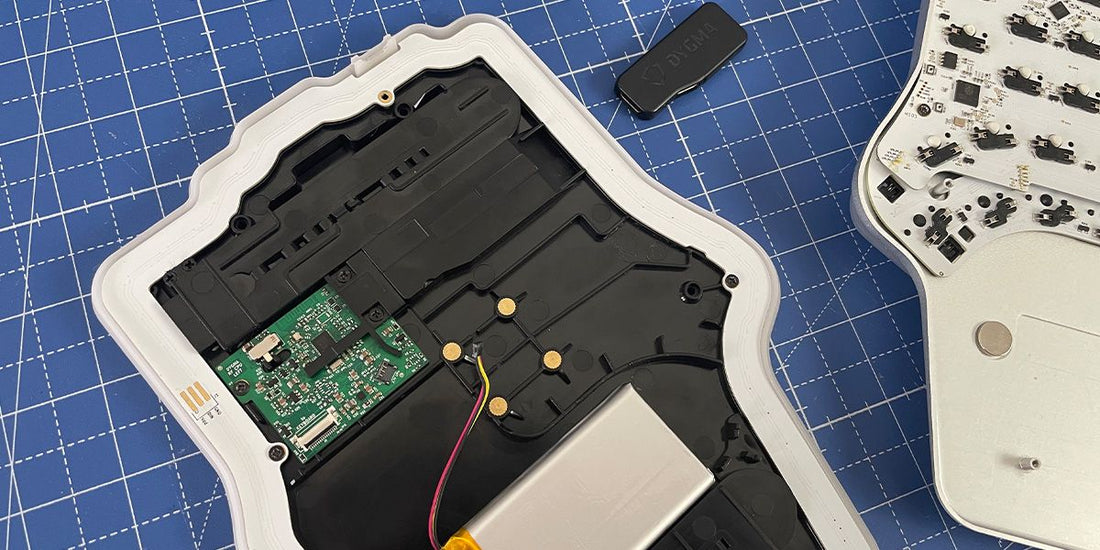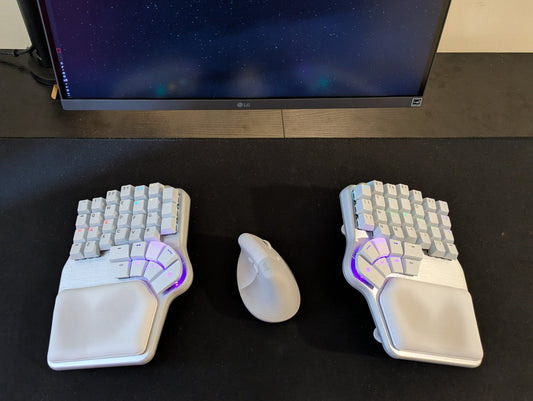A couple of weeks ago, we dedicated a full manufacturing update to see how the mechanical parts of the Defy were coming together.
It was pretty satisfying going over the samples and the details we want to improve, but as much as I’d love to keep showing you pictures of that, this week- It's time to take a look at the firmware & electronics 🔌
Because we can polish every detail of the design to perfection, but how would you feel if the Defy didn’t work as you expect it to?
That’s where the firmware and the electronics come in.
The next big milestone will be the Dygma Defy passing the CE pre-certification tests. To do that, we need to have working electronics and basic firmware.
We passed the wired keyboard test in July, which was huge for us, and we were supposed to do the same for the wireless version by the end of August ☀️

However, despite all our efforts, we’re still two weeks away from being ready for that, which means everything is delayed four weeks.
We expected to ship the Defy in December, and that date has now moved to January.
Sorry guys 😞
We’ve worked our butts off, but we’ve faced not one but three challenges:
- The chip crisis
- China’s zero Covid strategy
- The complexity of the Dygma Defy’s firmware
1. The chip crisis 📈
As most of you might know, there’s a worldwide chip crisis. This has affected our project greatly, although not tragically.
For example, it’s making our electronics engineer spend more time on the PCBs. The main problem is that some “minor” components that are usually cheap and easily available are now either completely unobtainable or so expensive that they render the project unviable 💸

That means that he has to search for other components that comply with our spec sheet, make the necessary adjustments to the design, find a supplier, negotiate the price, etc. And it’s a jungle out there 🌴
But most importantly, it’s affecting firmware development too.
We secured our critical firmware-related components long ago, like the RF Gateway, the Keyscanner, and the Neuron. And by secure, I mean that we paid the full price in advance to lock them in.
However, it turns out that is not enough nowadays: we needed to literally have them in our hands.
And we learned that the hard way 🤦♀️
Some of you might not be aware, but besides the Defy, we’re also manufacturing a new batch of our other keyboard, the Dygma Raise. This is our fourth batch, so it’s a pretty straightforward project that we could easily handle as a side task.
But then, one of our suppliers notified us that they couldn’t deliver the Keyscanner Microcontrollers at the agreed-upon and already paid price. It now cost eight times more. EIGHT! 😭
That’s a key component –it’s the chip that reads your key presses and sends them to the neuron– which meant we had to find another chip and adapt our firmware to work with it.

Our senior developer managed to do it without compromising the features, and the 4th batch of the Raise is already in assembly. But it took him 3 weeks to do so, and that’s time we won’t get back for the Defy project.
Of course, we have learned our lesson. Now we have all our chips REALLY secured. They are literally stored in a safe at our assembly facility in China.
2. China’s zero Covid strategy 😷
Then there’s China’s zero Covid strategy, which constantly puts neighborhoods and even whole cities into full lockdown.
For example, our electronics supplier has been shut down for the last two weeks, and we’re even struggling to get them to answer our messages, let alone send us components.
Plus, our supply chain manager has been quarantined on various occasions, and that has caused delays too, since he couldn’t visit the factories to do quality control, pick up samples, etc. He’s stuck at home 🏠
For example, if a package is stopped by Chinese outbound customs, and he can’t pick it up or go there to justify the content of the package, that sample is lost. Not even Columbo could find it🕵️♀️
There’s not much we can do about this. We want to send our Lead Product Designer, Manel, to China later this year, but he might face the same problems.
3. The complexity of the firmware
Finally, and to be completely honest, we underestimated how difficult creating the firmware would be.
From an electronics standpoint, the Dygma Defy is two different products (wired and wireless), but from a firmware perspective, it’s three products: wired, RF (2.4 GHz wireless), and Bluetooth.

We knew it wouldn’t be easy, but not THIS hard 😓
We hired a firmware developer half a year ago, we have two full-time freelance firmware developers working for us, and our full-stack developer is also knee-deep into the project.
But it’s not enough. So we’re finalizing the hiring of two more firmware engineers 👩💻
So, where are we with the Defy firmware?
Ok, those are the main reasons why the wireless Defy is about a month behind, but exactly how much progress have we made? Where does the wireless Defy stand as of now?
Well, on the electronics side, the keyboard is ready for the CE pre-certification test. That includes the PCBs for the switches with the keyscanner microcontrollers, the two RF gateway PCBs, the wireless Neuron, and, of course, the batteries 🔋

Of course, there will most certainly be changes to the electronics after the test, but we can’t move forward until it’s done.
So, what do we have on the firmware side? To understand that, I need to briefly explain how the firmware works.
Wired
For the wired connection, it’s pretty straightforward. When you press a key, the switch activates the circuit in the PCB, which is then read by the keyscanner microcontroller.

That microcontroller sends the input to the Neuron –the actual brain of the keyboard– that translates that into the actual keypress (or combination of keypresses) that your computer can understand 💻
That’s ready for the test 🔬
2.4 GHz RF
For the 2.4 GHz RF wireless connection, the keyscanner microcontroller sends the input to the RF gateway microcontroller, which then sends it wirelessly to the Neuron. The neuron then translates that input and sends it to the computer via USB.

In that sequence, we have the firmware for the RF Gateway microcontroller and the Neuron ready. Or, to put it in another way, we have a working connection between the gateway and the Neuron, and between the Neuron and the computer.
What’s not prepared is the connections between the keyscanner microcontroller and the gateway microcontroller. We were able to make it run under I2C, but we want it to be SPI to achieve maximum stability and the lowest latency possible.
Bluetooth

Bluetooth connectivity on the Defy works like this:
- The right side is connected to the left side via RF.
- That input is then sent to the Neuron, which is connected under the left side of the keyboard.
- Finally, the Neuron sends the key press to the computer via Bluetooth.
So far, we can send keystrokes from the left side to the Neuron and then to the PC via Bluetooth, but we still have to connect both sides wirelessly 📡

Ok, what next?
We aim to send the keyboard to the CE pre-certification test in the next couple of weeks.
Once we do that, and depending on the test results, we will need to adjust the electronics and continue working on the firmware 👨💻
That’s because the firmware for the test is not the final firmware. What we’ll have ready is basically capable of sending keystrokes and keeping a stable connection (simplifying a lot, that’s what you need for the test in terms of firmware).
We must include all the features that make the Dygma Defy a productivity machine: layers, combos, macros, superkeys… the lot.
On the electronics side, the challenge ahead is passing the pre-certification test. And there are some uncertainties.

With the aluminum top plate and so many electronics crammed inside, our keyboard is like a small Faraday cage; we need to ensure that the connection is strong and stable enough, which might imply making some changes to the electronics and even the mechanical parts 🪛
We’re confident to come on top, but we want to be transparent about what we foresee as a possible cause of delays. Our main goal is to deliver the best keyboard we can imagine, and we think you want that too.
We’ll continue publishing regular updates to keep you informed of all the latest developments.
A great thank you from the Dygma Team.
じゃあ 🇯🇵









